Essential Background
From the outset, this must be crystal clear: the Peak Design Everyday 30-liter backpack is not a dedicated mountaineering or field rucksack. It is a sleek yet unassuming backpack designed for camera gear, laptops, tablets, and daily work/commuter essentials. For these specific reasons, the pack piqued my interest. The company also appeals, as they practice corporate social responsibility, use sustainable/recycled materials, and are entirely crowdfunded (therefore, user input is paramount to product development).
I long-term tested the Everyday extensively in what could be called typical adventure travel and fieldwork situations. I carried it on overnight trans-Atlantic flights, regional puddle jumpers, seaplanes, and trains. It deployed from taxis, dusty truck beds, and spotless rental car interiors. Occasionally, it protected at least $10,000 worth of gear (multiple cameras, lenses, and a laptop). I didn’t intentionally search out adverse conditions, but I did use it for almost two years across a range of multi-season intercontinental work and travel destinations.
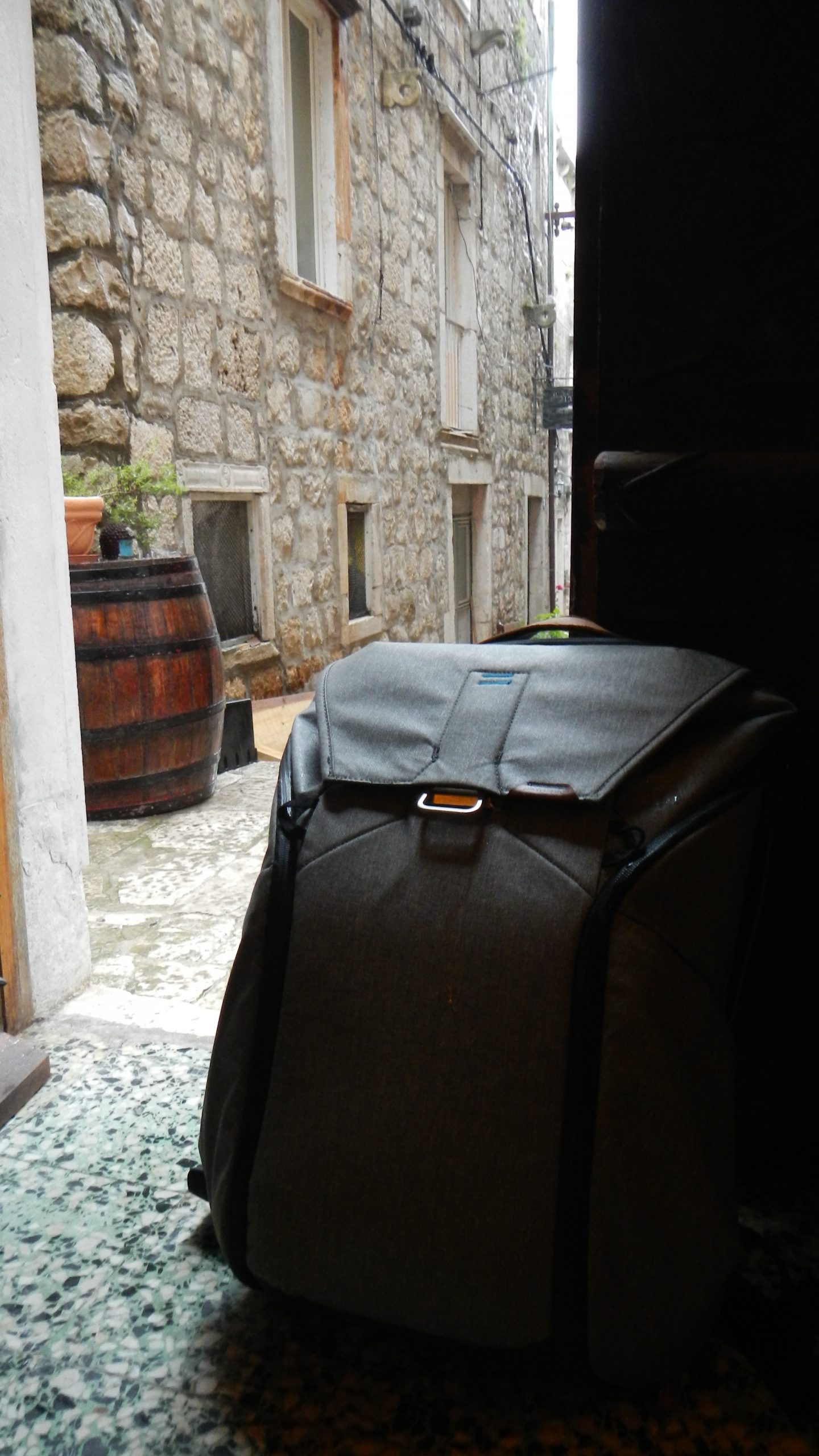
Where appropriate, the Overland International team pushes gear to operational limits not only to assess strong points and illuminate susceptible aspects but also to explore areas where designs and/or materials could be improved upon. Unlike a significant amount of our field test gear that is often provided by, or purchased directly from, the manufacturer or a distributor, this item was obtained retail from a local camera shop. I refrained from gleaning any outside input other than Peak Design’s web pages, and a few trusted professionals I asked to use and/or comment on the pack.
To obtain independent long-term feedback in an urban setting, I loaned the pack to a colleague I knew who could put it to hard use in daily commuter, municipal environments. A former Marine who transferred from a confidential branch of a major technology company to executive protection work in the Silicon Valley, he was an ideal candidate to separate the proverbial wheat from the chaff. After more than six months of metropolitan use, he provided comments but has yet to return the pack.
Initially, I felt this rucksack didn’t warrant mention in media mostly dedicated to motorized overland and expeditionary travel. The pack has some minor shortcomings, which became apparent while doing what many overlanders, remote travel enthusiasts, and expeditionary personnel do to gear: use it in more extreme conditions. Urban commuter or high-and-dry travel environments possibly wouldn’t expose these issues. However, it is a quality rucksack with unique features and potential that warrant respectful mention to the overland community. Peak Design recently released the Everyday 30-liter backpack V2 (version two). The second generation refined some aspects (primarily consisting of slight tweaks to the profile, material, zippers, and nuanced adjustments to the straps, pulls, and side pouches). Having examined V2, I can state that primary design concept elements clearly carried through, and those are the main points critiqued here.
General Design and Specs
Available in 20- and 30-liter volumes, the daily carry packs Peak Design created have understated exteriors, yet sophisticated and technical interiors. Aimed for those primarily working in, and transitioning between, urban and suburban work/play settings, the Everyday’s configuration is highly versatile.
The pack comes with unique FlexFold inserts that use hook-and-loop technology (albeit more refined than standard Velcro) that allows users to customize the pack’s interior. These inserts, reminiscent of Japanese origami paper sculptures, have multiple fold and attachment points. After some uncomplicated trial-and-error fitment, the user will have a very dialed-in, compartmentalized interior that maximizes the entire space, with various ways to access gear.


I tested a few interior configurations for varying items and field applications. However arranged, my favorite aspect is that if you forget where something is, just unzip one of the side flaps and pull it open. Not there? Quickly flip the pack over and repeat. You won’t disturb a tidy packing job. Imagine almost never needing to rifle down through the backpack’s top opening to access the middle or bottom of the main compartment.
My first arrangement includes running with a Sony A7 mounted to a 70-200mm lens, with a smaller prime secured nearby, and a Leica MP with Summilux 35mm f/1.4 and four extra film rolls. These items and their supporting bits (charger, extra batteries, etc.) are neatly organized in separate padded FlexFold compartments. I unzip either side pouch from its bottom zipper and remove the camera. Why does this matter? If external conditions are less than favorable (e.g., rain, dust), I try to extract my camera’s body back first to keep the front lens elements clean, so the camera is immediately ready to shoot. In this configuration, I leave the pack’s remaining main interior compartment (the unused space above the camera gear) completely open for an extra jacket or sweater, wool beanie, literature, and snacks.
Another configuration I favor uses two horizontal spaces across the bottom of the pack (essentially, partitioned off from the rest of the main compartment with FlexFold). In this space, I usually store a water bottle, covered notepad, and trauma kit—items to which I prefer immediate access. These are revealed via either side zipper. This arrangement then leaves a cavernous main space accessed from the pack’s top flap for travel clothing, foul weather gear, Dopp kit, snacks, and solo camera/lens. The small magnetic closure interior compartment by the top flap is handy for small items like flashlights or batteries.

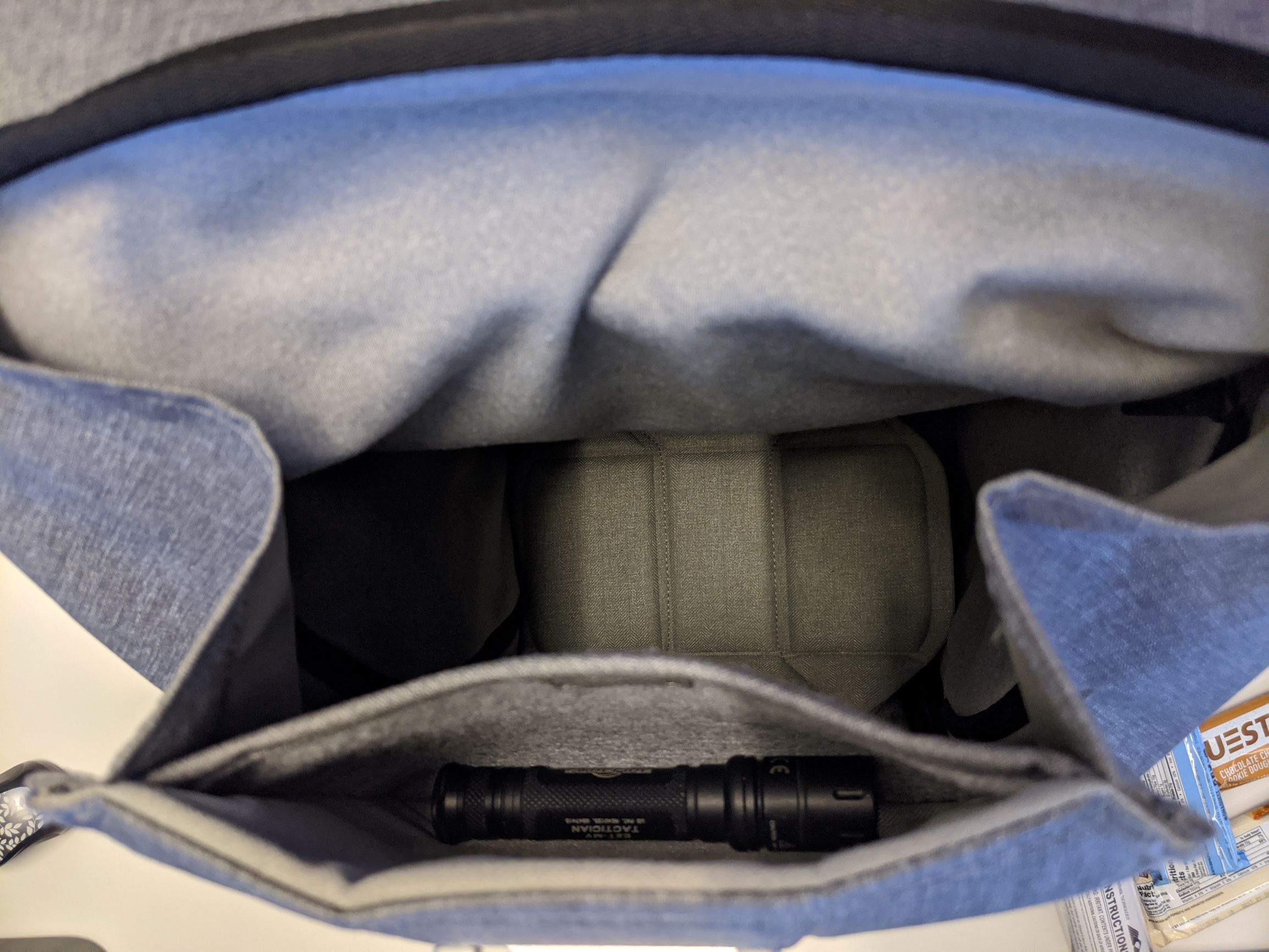
Laptop/tablet storage happens in a different location. Behind the top flap, running the full pack width is a discrete zipper access to a large partitioned pouch specifically designed for laptops and tablets (folders and the latest copy of Overland Journal will also slot in). It isn’t a hidden section, but someone unfamiliar with the pack would not intuitively look there to find a computer. When the adjacent main interior compartment on the Peak Design is packed to the gills, a laptop still inserts without hassle. This is extremely handy, especially when constantly traversing airport security, or if discretion is required when removing that gear. There is no fumbling around or opening the main compartment, and no destroying your pack job or fiddling about trying to stuff the laptop back inside.

The side flap interiors also set this pack apart. Side zipper access on main rucksack compartments is not new, but this design excels because it facilitates a full view of, and contact with, the entire contents from both sides of the pack. Furthermore, they pad the main compartment and provide water-resistant storage for administrative items, travel documents, and daily carry gear. There are two zipper pulls per flap, one at each end when the pouch is closed. I found this design very handy and secure, especially when the pull is looped through the pickpocket prevention tab.
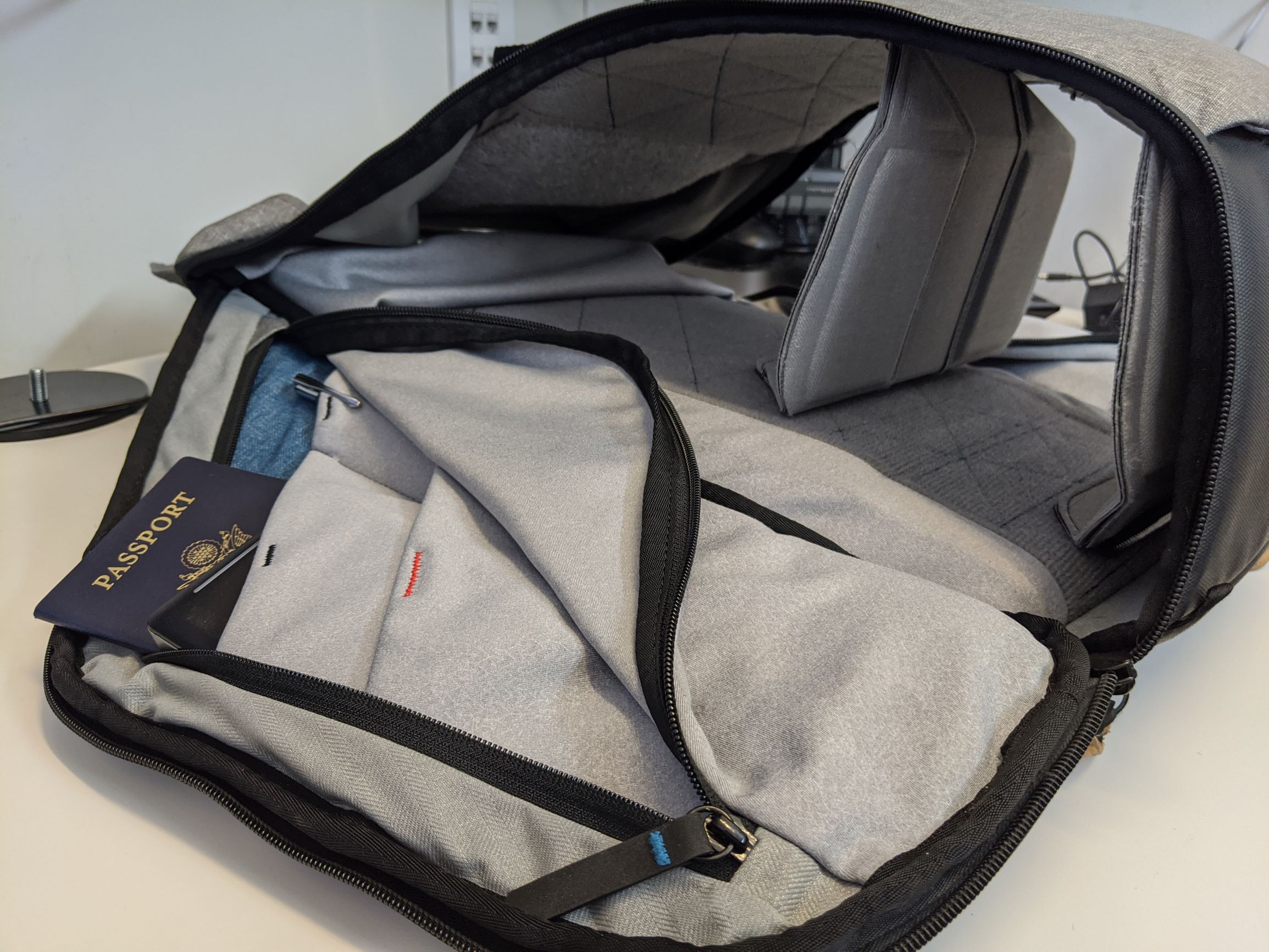
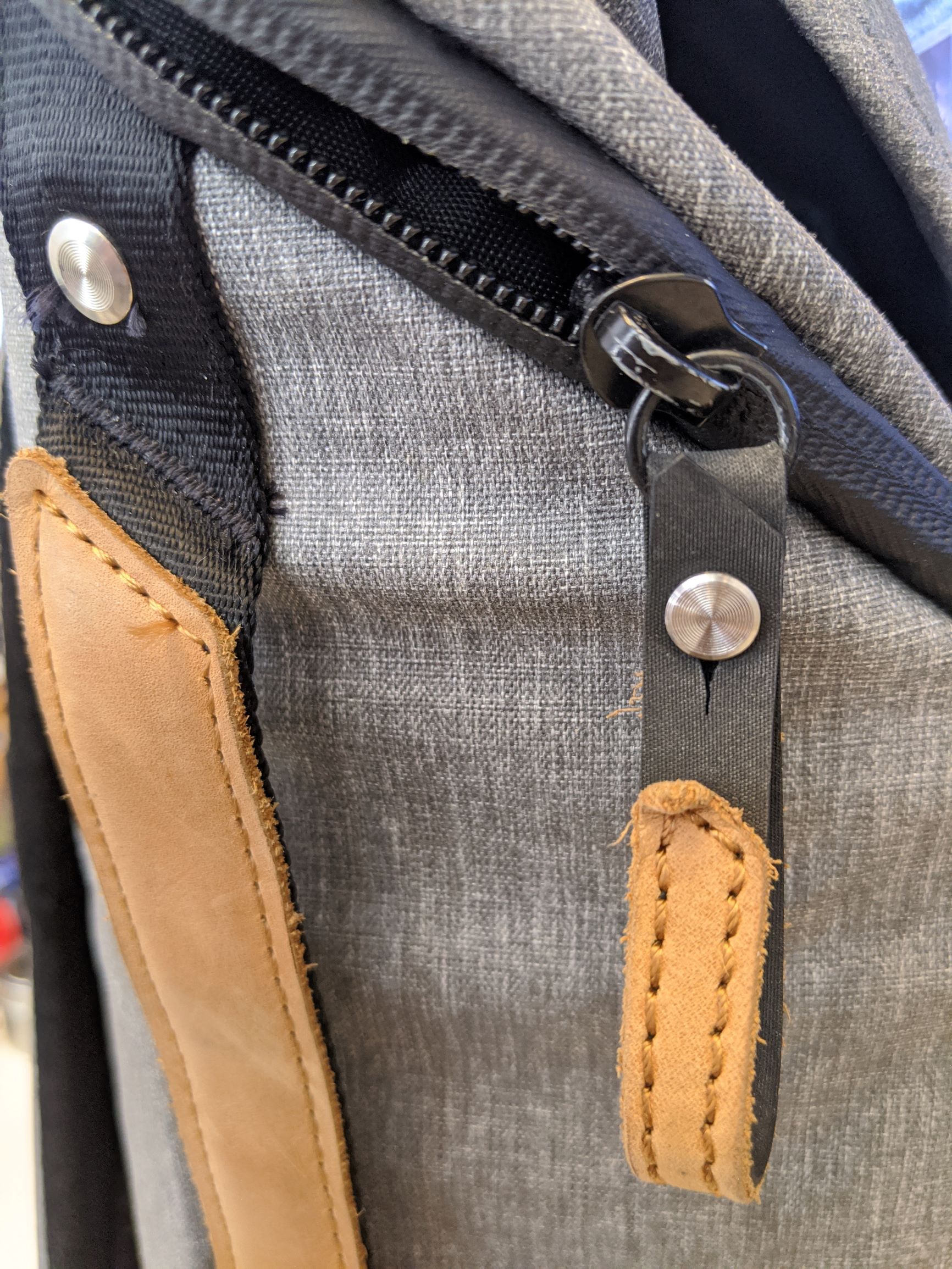
Like many backpacks, the main compartment has a protective flap to cover the contents. In this design, siding fabric collapses inward as the top cover folds over and clamps down. There isn’t a cinching cord or strap. The unique MagLatch magnetic buckle on the flap has four attachment points on the pack exterior. This closure system makes the pack appear less rugged and more commuter stylish. However, this buckle system never inadvertently opened or failed to secure shut, even with a full pack.
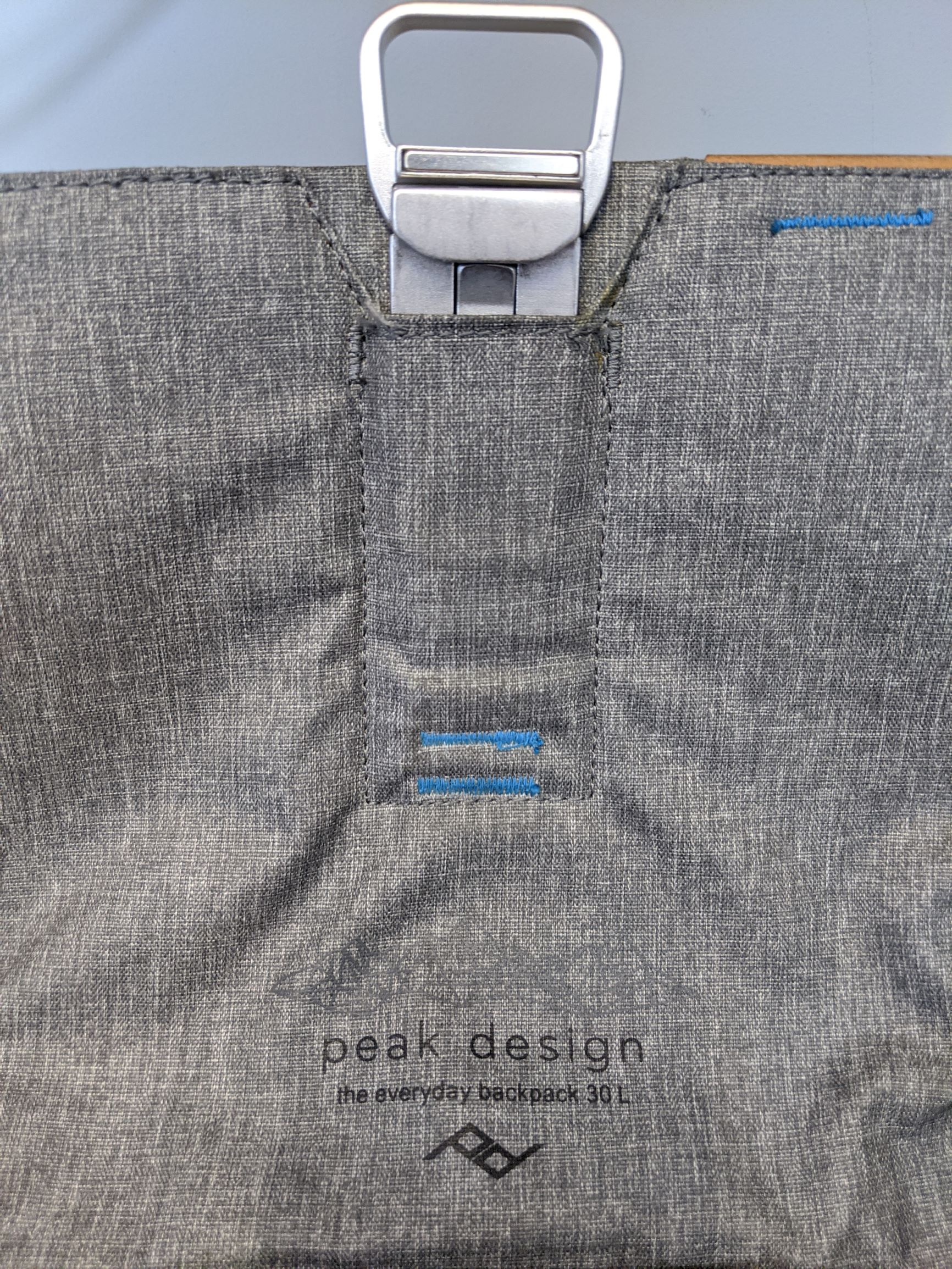
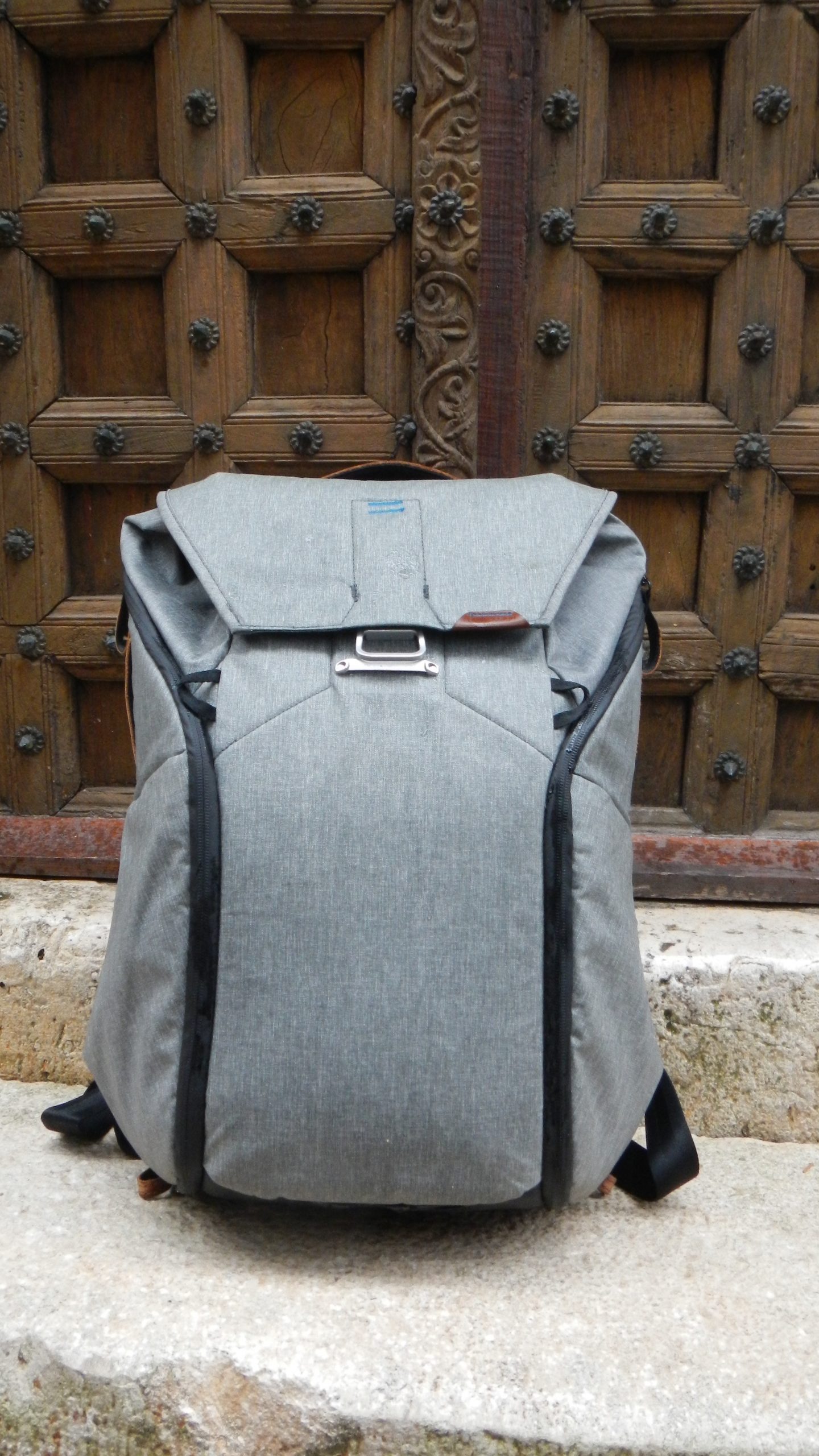
The sternum strap stabilizes the load up top and is affixed with an efficient proprietary clip system. The shoulder straps felt fine even with a full load. The V2 has slightly more padding, ergonomics, and magnetic strap holds. It also has a tuckable, minimalist waist strap.
Discussion
The marketing appears to be aimed, in part, at serious enthusiastic amateurs and professional photographers. This customizable design promotes intuitive access to photographic gear without exposing the entire contents to the elements-or nearby eyes. I’ve used a few backpack systems for photographic equipment, and this one really shines in this area. On the capacity side, for those who require multiple bodies and a wide selection of lenses, the main compartment may quickly fill up with gear, leaving minimal interior room for items like spare clothing. This isn’t a deal-breaker, just something to check regarding your photographic equipment.
I appreciate that the camera components can be stored in a completely separate location from the laptop, so their requisite cables and parts don’t need to commingle. I can’t fully accomplish this with my Pelican Case or other packs I carry. The pack certainly doesn’t look tactical or mountain rescue ready. The gray color, what Peak Design calls Ash, is reminiscent of the old salt-and-pepper rucks the Swiss Army once issued. The exterior is uncluttered, with no daisy chains or MOLLE. The colors Peak Design uses for this line are what I’d call urban generic. With the Everyday resting against your leg at a café, no matter the contents, it doesn’t tend to draw immediate attention. The shape lends well to aerodynamics when riding a motorcycle. However it’s oriented, the ruck should slot into common-sized overhead aircraft bins without issues, and the side and top grab handles are well placed.
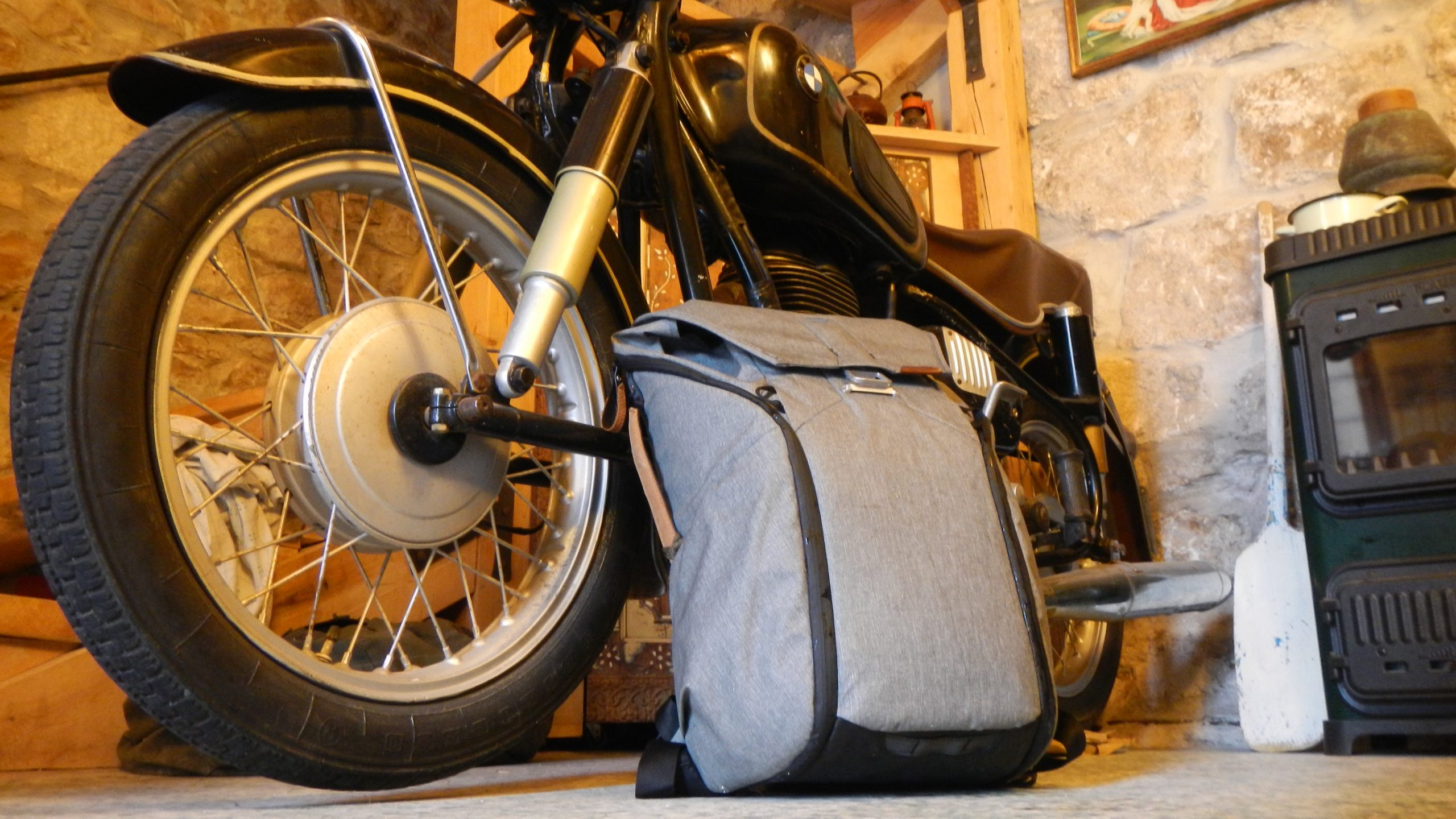
A characteristic we stumbled upon, one that I’m sure consummate V1-2 users already discovered, is attaching items other than the FlexFold dividers to the pack’s interior. There are a myriad of Velcro or similar hook/loop attached products available ranging from organizational pouches, flashlight holders, medic kits, holsters, etc., that should be readily secured inside the backpack’s main compartment. This allows for a customized interior way beyond Peak Design’s off-the-shelf options.
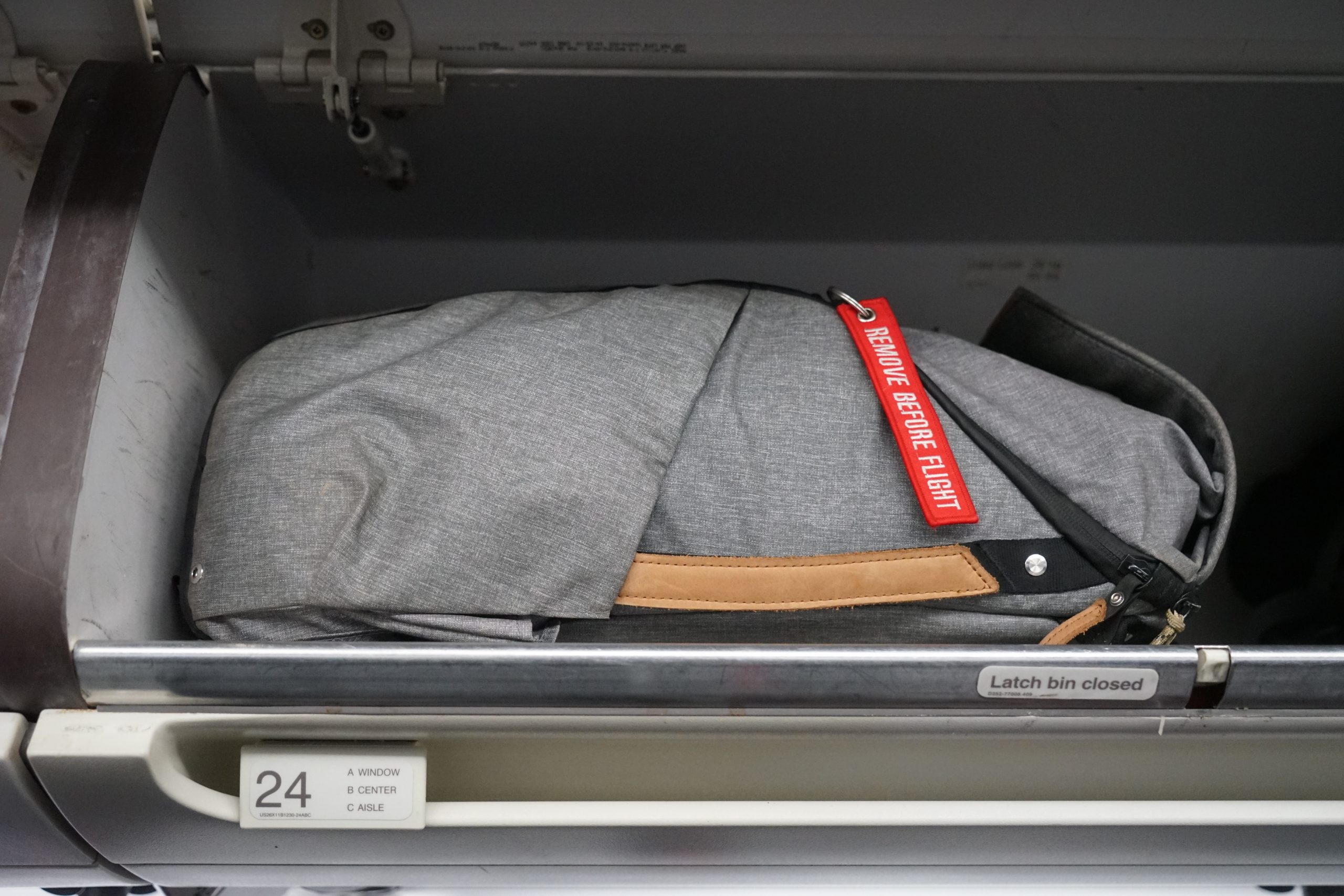
While working on an island in the Adriatic Sea, I walked in a downpour from a hardware store to the project location. After no more than a brisk 15-minute walk, moisture had already begun seeping into the pack via the water-resistant top zipper’s sewn seam with the pack material (see accompanying image). Spray also entered in from the side, just under the top flap. I had a laptop and some file folders with important documents in the pack. I didn’t notice any water going through the pack’s body material (on that note, it also resists coffee stains and repels beer quite well). The V2 zippers have been upgraded, as stated by Peak Design, to be more robust. However, the sewn seams need to repel water or integrate with a design feature that does (e.g., taped seams or a flap). Regarding the circumstances, although this was an overseas work location, it wasn’t any different than getting caught out in any urban or commuter setting.


The top flap secures fine, and the siding material folds tidily inward. However, since there is no cinch possibility, this leaves side gaps through which horizontal rain or dust can easily enter the main compartment. I experienced both incursions, not good for many contents, electronic or otherwise. Therefore, the main space would benefit from a cinch of some manner or a rain cover stored in the pack’s base.
I mentioned stashing water bottles inside the pack, instead of the external pockets. It doesn’t matter that the new side pockets have more volume, the design still promotes bottles sliding out. The slots are adequate if the pack remains entirely upright. However, if the pack is turned horizontal, to access a camera or when bending over to retrieve something, bottles tend to fall out. A tuckable/securable covering flap would prevent this, in conjunction with a more tenacious lining. I did like these side pouches for storing folded newspapers, small books, and snack bars. Those items weigh less and were significantly less prone to falling out. Storable lashings with subtle attachment points can be deployed to secure external gear like jackets.
It doesn’t look like it should be at an Everest base camp or in some remote refueling point in the Kalahari Desert. I find that refreshing. The pack has a clean and professional appearance, reflecting a design aimed more at urban jungles rather than sweltering savannas. It’s low profile, durable, and adaptable. Interestingly, there aren’t many comparable packs in this specific niche. The ease and discretion of access, especially when traveling in/working from restricted quarters like aircraft, buses, autos/trucks, even office cubicles, make the design stand out. Upgrades have moved it in the right direction. With a few more design tweaks not realized in Peak Design’s Everyday backpack V2, it would excel as a versatile everyday backpack for work, adventure travel, and those unpaved destinations. Various colors are available (ash shown), and a lifetime guarantee covers product defects. Soft goods are made in Vietnam; hard goods are manufactured in China.
$260 | peakdesign.com
For Bryon, overland travel is often vocational necessity rather than a purely adventurous pursuit. To accomplish field research for a PhD in archaeology, he frequently rode a gear-laden BMW R100GS/PD roundtrip from Scotland to Croatia. He then worked as a contract archaeologist, taught field survey and excavation, and collaborated with the Department of Pre-and Protohistory, University of Zurich, before starting a consulting company. Work has led him to the Middle East, South Pacific, Americas, Africa, and Europe. Bryon is a photographer, scuba instructor, pilot, wilderness EMT, and certified public safety off-pavement vehicle operations instructor. He also conducts specialized safety courses for workforce members deployed to adverse locations, is on a search and rescue team, and serves in a law enforcement diving unit.



